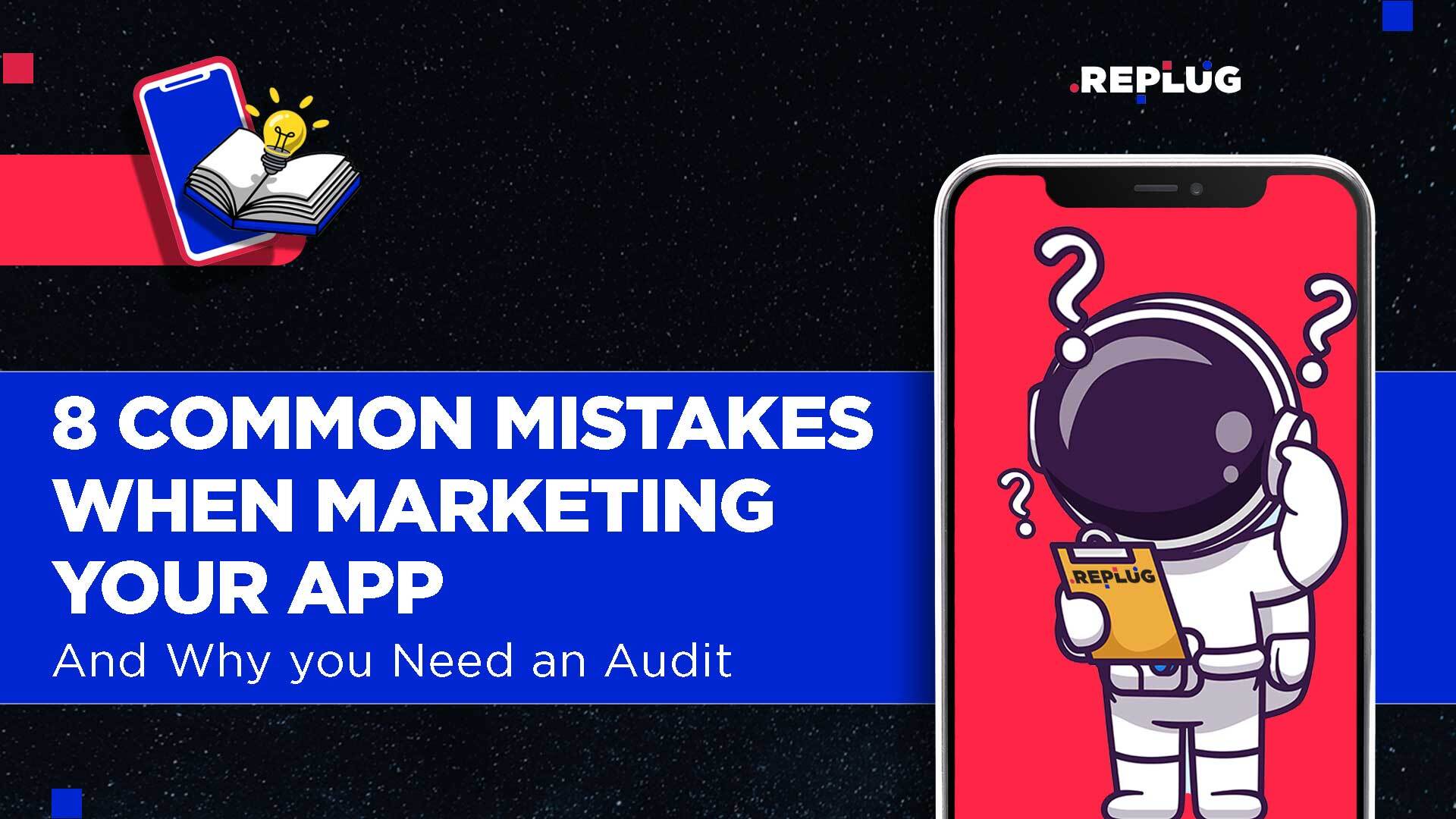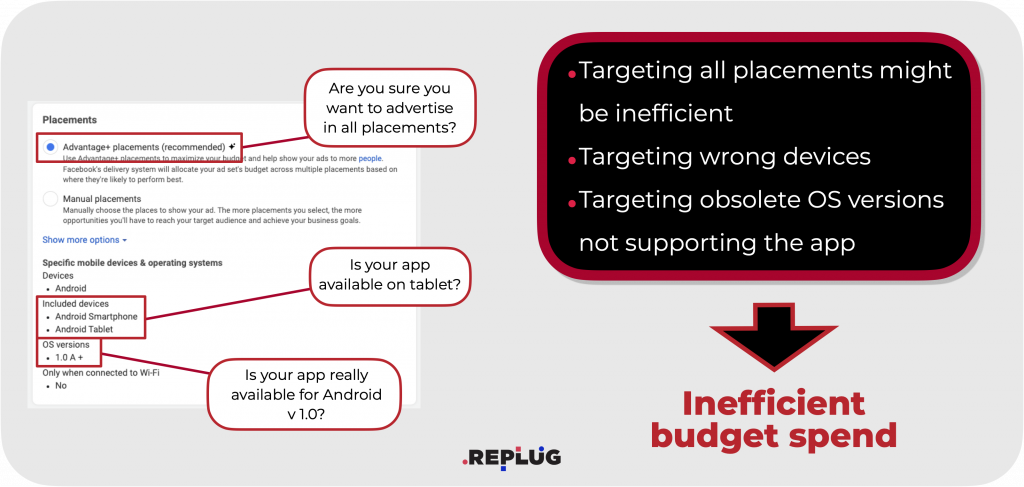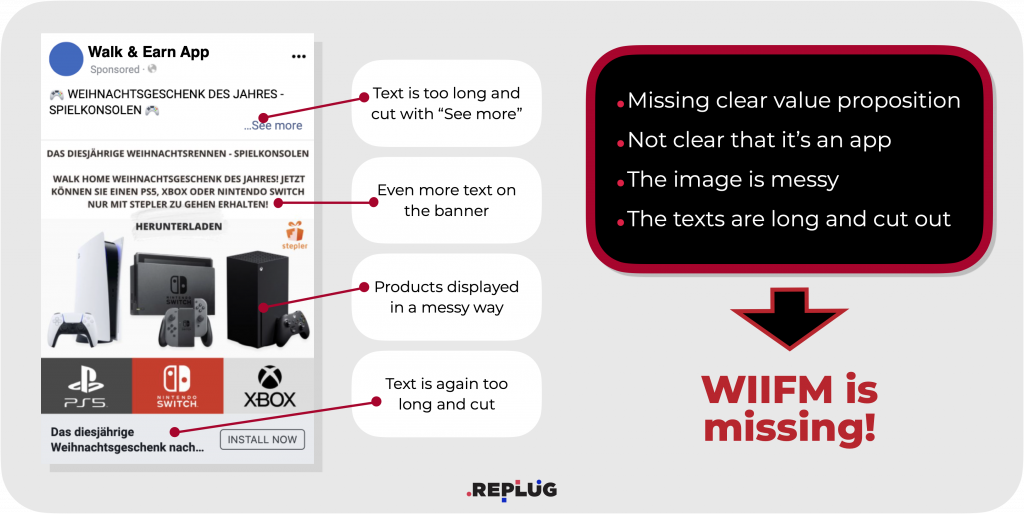8 Common Mistakes When Marketing Your App (And Why Do You Need an Audit)

We’ve been saying that in many circumstances and articles: app marketing is not a piece of cake – it’s never been and will never be. Especially in light of recent disruptions the mobile industry faces, app marketing has evolved into a field of action that requires maximum attention and care to every detail.
At REPLUG, we believe that only excellence can lead to success (not only in Paid UA, of course), and in 2023 if you want to achieve great results when promoting your mobile app, you need to aim for perfection.
However, as far as perfect we’re trying to be, it is not humanly possible to avoid 100% common mistakes when marketing your app, and hence our job becomes one of reducing the mistake margin as much as possible.
8 Common Mistakes App Marketers Do
To help you do so, we’ve created a list of common mistakes when marketing your app and running paid UA campaigns – from setting up the tracking tool to optimizing creatives.
We were able to do so by analyzing – during the several audits we conducted – tens of advertising accounts and MMP settings, talking to several marketers and partners, and, of course, learning from our own mistakes.
The result is summarized in this article, where we collected the eight most common mistakes that – if avoided – can help you successfully promote your mobile app.
Download our ultimate tracking and MMP setup checklist. Our expert consulting team worked hard on every single detail. Therefore, you will be 101% sure that you are on the right path.
1. The MMP Setup Is Not Correct and Tracking Is Not Possible
Tracking and attribution have always been the most, if not the most important, part when it comes to promoting your app: if you can’t properly track the results, you’re unable to determine the effectiveness of your budget spending – and therefore you won’t be able to scale efficiently.
However – some of the most common mistakes when marketing your app are related to tracking and attribution. And if you’re asking yourself if Firebase is a tracking tool, that’s already a huge first mistake. If you use Firebase, you won’t be able to track your results properly.
What to Focus On
Before starting with any kind of campaign, make sure that your MMP is properly set up in terms of attribution windows, that all the channels are connected to the MMP, and, most importantly, that the SKAdNetwork is ready to track your main events.
Be Careful
Be sure to track Meta installs through the MMP connection, not the Facebook SDK. It is also crucial that all the main in-app events are passed from the app to the MMP. Doing an in-app event mapping is recommended to ensure you’re not missing anything.
The Consequences of a Wrong MMP Setup
Starting mobile paid user acquisition activities without being able to track results properly can lead you to make wrong assumptions and make decisions that are not data-driven. And, therefore, very often, bad choices.
2. Basic Mobile Paid UA Strategy: The Duopoly Doesn’t Exist Anymore
We once used to say that if you could scale Facebook and Google Ads (the advertising duopoly), you didn’t need anything else to succeed in paid user acquisition for mobile apps. This is obviously, not true anymore.
Nowadays, with the high competition and data limitation, if you want to succeed and scale, you need to keep your eyes well open and look for opportunities: from the traditional channels to new ones, from online, to offline – you can “meet” your audience everywhere.
However, too many app marketers fall into a “laziness” trap, and they always go for the easy solution.
What to Consider
Scaling a single channel is becoming more difficult than it used to be. You need to test different ones. Go fast, break things, try everything, collect data, and optimize. Think about retargeting your users, splitting genders and age groups, and analyzing the results.
Most importantly, do not base your strategy on your problems: do not invest in Apple Search Ads only because it allows you to track better than Facebook and TikTok; invest in Apple Search Ads because it is a good channel, and focus on solving the tracking problems so that you can also run other channels.
Go Out of the Box
Consider retargeting, OOH (out of home) activities, cooperations, and proximity marketing – stop thinking basic, and start thinking big about your mobile paid user acquisition strategy. As we say at REPLUG: eat, sleep, test, repeat.
3. Sloppy (And Broad) Targeting Strategy


One of the most common mistakes when marketing your app everybody falls into is thinking that – after iOS 14 – targeting is no longer possible. That couldn’t be farther from reality.
It is true that with the increasing attention to privacy and due to the iOS 14 limitation, it is now more challenging to target your ex-partner living across the street with a personalized ad reminding them of that fantastic holiday in Bali.
However, if you are careful with details, delivering your message to your desired target audience is still possible.
What to Keep In Mind
We see (way too) many advertisers, across different channels, especially in the paid social ones, that are solely focused on broad targeting strategy without even considering look-a-likes or interest-based targeting. The efficiency of the look-a-like audiences has indeed been decreasing in the past years, but that doesn’t mean it might not work.
Another common mistake when marketing your app is often related to exclusions or limitations: it’s not uncommon to see campaigns targeting OS versions or devices not supported by the app (are you really sure that your Android app is supported by a phone with a Lollypop OS installed?).
The Consequences of a Sloppy Targeting Strategy
A sloppy targeting strategy will cause you to waste your budget by showing ads to users that are not relevant and not interested in your service. That is a budget that could be used for other channels or activities.
4. Apple Search Ads Centered (And Wrong) Mobile Paid UA Strategy
As mentioned earlier, we often see an increasing focus on Apple Search Ads due to missing tracking capabilities for other channels. Do not be mistaken – Apple Search Ads is a great paid user acquisition channel that can bring excellent results with the right strategy and for the right app.
However, the scaling capabilities of this channel are limited, even with the Apple Search Ads’ new placements (whose performances we’ve recently analyzed in this article). For this reason, if you’re advertising a niche app or a kind of app with very low search volumes, it’s going to be difficult to scale the spending.
Unless you let Apple go crazy with discovery, but, as we identified during several audit processes, the efficiency is affected negatively in that case.
What to Consider
Take your time to create a proper Apple Search Ads strategy. The first common mistake to avoid – choosing the Basic Apple Search account: always go for Advanced to have more targeting capabilities, choose your own keywords, and have control over the budgets, as well as test the new placements.
Start from the best practice campaign setting: divide brand-related keywords from generic and competitor keywords, and create a discovery campaign.
If you have an app with multiple – and different – USPs and features, consider creating more generic campaigns, each dedicated to different USPs.
Be Careful
Do not use broad-match keywords (and deactivate the search match functionality) unless it is a discovery campaign. And never mix broad-match keywords with exact keywords.
Related: Tips on How to Measure ASO Success in 2023 (Plus Bonus Advice)
The Consequences of a Wrong Apple Search Ads Strategy
Having a wrong Apple Search Ads strategy – either wrong in terms of setting or too much at the center of the overall strategy – can lead to, once again, incorrect assumptions and bad decisions
5. Too Much or No Google Ads and Android Budget
There are two types of app marketers: “let’s ignore Google because it has a low LTV” and “let’s move all the budget to Android because it has a low CPI and we can track everything.” Well, let me tell you: both are wrong, but one will surely fail, and it is the second one.
Moving all your budget to Android because it has better CPIs, and you can track all the installs and in-app events will have dramatic consequences in terms of other important KPIs such as conversion rates, retention, and eventually LTV. We know very well that iOS users have better quality.
Nevertheless, forgetting about Android is a mistake because you can achieve decent results with a good targeting strategy (not sloppy) and proper channels.
What to Keep In Mind
Google Ads can be a good channel for acquiring users for your mobile app, but it can’t be the only one, and most importantly, the choice of Google as your primary channel for mobile paid user acquisition can’t be based on the low CPIs.
Be careful when allocating the budget, and analyze all the funnel conversions and the revenues. If the low cost of acquisition results in a positive ROI, it makes sense to invest in Google and Android in general.
But, after analyzing the results, we see that the budget allocated to Android is, in most cases, way too much.
The Effects of Overspending (Or Not Spending) On Android
As we mentioned, putting all the eggs in the Android basket could lead you to draw quite the wrong conclusions regarding the profitability and LTV of your mobile business. On the contrary, omitting Android completely could make you miss opportunities to increase your revenues.
6. One-Size-Fits-All Creative Strategy


The creative part is still one of the main drivers to achieve great results on mobile paid user acquisition for mobile apps. The concept of “a great creative can bring good results even with a wrong targeting” has never been so true, especially with the recent limitations in targeting capabilities, especially on Facebook.
Nevertheless, sadly, during our paid UA audit process, we generally see so many bad ads, wrong in format, dimension, and even concepts.
Mistakes to Avoid When It Comes to Mobile App Creatives
- The value proposition is unclear: the WIIFM – What’s In It For Me – should always be well explained.
- Use the same creative concept for all the channels: have you ever read that each channel has its own audience? Then stop using the same creative you use for Instagram also for TikTok. They are both vertical, but they’re totally different platforms.
- Use only one creative format: there are so many different options, banners, carousels, slideshow, videos, animations, and user-generated content – yet, so many advertisers only use one format. Why?
- Do not personalize creatives for each placement: size matters in this case. How many squared ads did you see on Instagram Stories? Or how many cut videos?
- Use too much text (both on the graphic and the ad copy): if it’s creative, it should be mainly an image.
- Missing call-to-action: people need to be told what to do.
- Missing reference to the fact that it’s an app: people have a few seconds to understand what the ad is about.
- Being too much click-baiting: it’s true that we need to maximize clicks to have more installs. However, at the same time, if you use a strategy to maximize clicks, you risk lowering the conversion rate for installs and, eventually, per in-app action.
The Consequences of Having a Bad Mobile App Creative Strategy
Well, that’s easy: bad performances, hence a waste of money. You only have a few milliseconds to get the attention of the person scrolling through the Facebook, TikTok, or Google feed.
Related: Trying TikTok Spark Ads: Our Experiment and Insights
That’s why you need to use a performance marketing approach when it comes to creative strategy for app marketing purposes. In most platforms, you pay handsomely per mille impressions (CPM), and your objective is to get as many conversions as possible from those impressions.
Moreover, that’s why a good metric to look at is the IPM (Installs per Mille impressions) or cEPM (Conversion Events per Mille).
7. Looking at the Wrong KPIs
The importance of looking at the right KPIs sounds clear, yet, sometimes, we can get lost with so much data we have at our disposal. Ending up making such common mistakes when marketing your app can also be due to focusing on the wrong KPIs.
What to Consider
Each step of the funnel has its specific KPI to control. CPM, CTR, and Install Rate are certainly important for understanding creative performances, but there are many more KPIs to remember.
Nowadays, quality and monetary KPIs such as LTV and ROI are essential to determine the profitability of your app marketing campaigns and your business.
In this article, we talked about the Top 10 Mobile App Performance KPIs You Must Measure in 2023.
The Consequences of Looking at the Wrong KPIs
It’s, once again, pretty clear that the consequences of looking at the wrong KPIs when evaluating our app marketing efforts can be disastrous. On the one side, you might think that you’re too good and hence waste a lot of money.
On the other hand, if you underestimate the performance of your app marketing activities, you might lose opportunities to scale and make additional revenue.
8. Not Having a Holistic App Marketing Strategy
One of our pillars in app marketing and paid user acquisition, in particular, is the holistic approach, a theory well embodied by our Growth Rocket Model.
Nowadays, app marketing, it’s not anymore about Paid UA only. Nowadays, we need to consider all the areas of app marketing because they’re all interconnected.
However, during our audits, we see advertisers spending big budgets too often while having a bad app store page or, even worse, a bad user onboarding or no retention strategy.
What to Keep In Mind
It’s essential to understand the concept of “interdependence” when it comes to a holistic approach.
For example, if I spend $1,000 on paid user acquisition and get 1000 installs, the CPI is $1. If only two people register out of the 1,000 installs, I will have a registration rate of 0,2% and a Cost per Registration of $500. If I manage to bring the conversion rate to 20%, I will have 200 registrations and a final Cost per registration of $5.
Of course, the previous one was just a simplified example, but it can be applied to every step of the funnel, from the impression to the conversion event and the repetition of it.
So, if you have a great and clear app store page, you will have a better install rate. If you have a great onboarding experience, you will have more users moving the first steps in the app and fewer users deleting the app after one session.
If you have good CRM campaigns, you will get your users to stick with your app long-term, eventually converting and generating revenues.
Everything is interconnected, and each part of app marketing plays a huge role in the final LTV.
The Effects of Not Having a Holistic App Marketing Strategy
Of course, if you fail to look holistically, you fail to optimize and get good results. You could think that your paid user acquisition campaigns are not good, while eventually, it is just about the onboarding, or vice versa. You might think your registration process is bad when it’s just about wrong targeting or ads that do not explain the app clearly.
Conclusion on Common Mistakes When Marketing Your App
As mentioned at the beginning of this article, app marketing is not a piece of cake, and nobody judges you if you make one or more of the common mistakes when marketing your app we’ve listed above.
With so many things to do and so many – and continuous – changes in the mobile industry, from time to time, it might be easy to forget something or overlook a few details. Unfortunately, every detail makes the difference when it comes to succeeding in-app marketing. That’s why we believe asking for second opinions is very important.
Sometimes a fresh, external eye can see things differently and notice clear fallacies that were not visible to your eye because, once again, you’re very busy, and because seeing the same thing day in and day out, you get accustomed to the status quo.
We hope this list will be a starting point for you to begin correcting app marketing mistakes you might have made. But also, don’t be afraid to talk to your peers and ask for second opinions or external support.
And if you need a professional external eye, don’t hesitate to get in touch.
Our team will be more than happy to explain why the REPLUG audit is what you need to scale your app marketing activities.
